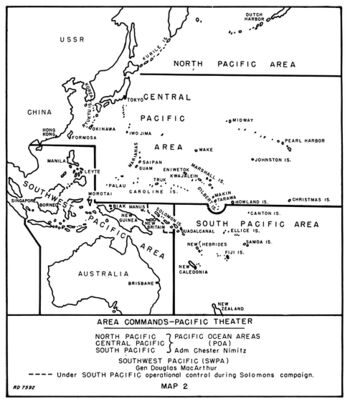Pacific Ocean Areas: Difference between revisions
imported>Russell D. Jones (Included content from United States Pacific Command) |
mNo edit summary |
||
| (7 intermediate revisions by 3 users not shown) | |||
| Line 1: | Line 1: | ||
{{Subpages}} | {{Subpages}} | ||
During [[World War Two]], the '''Pacific Ocean Areas''' was the name given by the [[Joint Chiefs of Staff]] to operational areas in the [[Pacific Ocean]] under the command of [[Chester W. Nimitz]]. Nimitz, | [[Image:Ww2-pacific-theater.jpg|thumb|left|350px|Map of the theater of operations in the Pacific Ocean and East Asia during the [[Second World War]]. Charles W. Boggs Jr., ''[http://ibiblio.org/hyperwar/USMC/USMC-M-AvPhil/USMC-M-AvPhil-1.html Marine Aviation in Philippines]'' (Washington: Historical Division, Headquarters, U.S. Marine Corps, 1951), 2. ]] | ||
During [[World War Two]], the '''Pacific Ocean Areas''' was the name given by the [[Joint Chiefs of Staff]] to operational areas in the [[Pacific Ocean]] under the command of [[Chester W. Nimitz]]. Nimitz, formally designated '''commander-in-chief, Pacific Ocean and Pacific Oceans Areas''' used the abbreviation CINCPAC. | |||
In the [[Second World War]], there was no single Pacific command. This was done primarily to avoid personality conflicts with [[Douglas MacArthur]]. Faced with balancing unity of command in any situation involving both the immense ego and talents of MacArthur, as well as the immense talents and relaxed personality of Nimitz, the [[Joint Chiefs of Staff]] split the Pacific Theater of War into a [[Southwest Pacific Area]] under MacArthur, while Nimitz commanded the Pacific Ocean Areas, which included the North Pacific Area, Central Pacific Area, and South Pacific Area. Most of the operations under Nimitz's command occurred in the Central Pacific Area. | In the [[Second World War]], there was no single Pacific command. This was done primarily to avoid personality conflicts with [[Douglas MacArthur]]. Faced with balancing unity of command in any situation involving both the immense ego and talents of MacArthur, as well as the immense talents and relaxed personality of Nimitz, the [[Joint Chiefs of Staff]] split the Pacific Theater of War into a [[Southwest Pacific Area]] under MacArthur, while Nimitz commanded the Pacific Ocean Areas, which included the North Pacific Area, Central Pacific Area, and South Pacific Area. Most of the operations under Nimitz's command occurred in the Central Pacific Area. | ||
While there had long been a Pacific Fleet, there was also an Asiatic Fleet in the late 1930s and early 1940s. Japanese victories over the Asiatic Fleet at the start of the war and the problems associated with the short-lived [[Australia-Britain-Dutch-American command]] (ABDA) made a western Pacific command irrelevant. A [[China-Burma-India | While there had long been a Pacific Fleet, there was also an Asiatic Fleet in the late 1930s and early 1940s. Japanese victories over the Asiatic Fleet at the start of the war and the problems associated with the short-lived [[Australia-Britain-Dutch-American command]] (ABDA) made a western Pacific command irrelevant. A [[China-Burma-India theater]] was formed, but was principally a British land command with a U.S. subcommand for China, and was rarely part of the MacArthur-Nimitz rivalry. | ||
Some unification was planned had there been a land invasion of Japan, but MacArthur and Nimitz essentially stayed co-equal through the Second World War. | Some unification was planned had there been a land invasion of Japan, but MacArthur and Nimitz essentially stayed co-equal through the Second World War. | ||
The Pacific Ocean Areas evolved into the | The Pacific Ocean Areas evolved into the U.S. Pacific Command after the war, the commander of which was still called CINCPAC. A four-star subcommander was Commander-in-Chief, U.S. Pacific Fleet.[[Category:Suggestion Bot Tag]] | ||
Latest revision as of 16:00, 30 September 2024

During World War Two, the Pacific Ocean Areas was the name given by the Joint Chiefs of Staff to operational areas in the Pacific Ocean under the command of Chester W. Nimitz. Nimitz, formally designated commander-in-chief, Pacific Ocean and Pacific Oceans Areas used the abbreviation CINCPAC.
In the Second World War, there was no single Pacific command. This was done primarily to avoid personality conflicts with Douglas MacArthur. Faced with balancing unity of command in any situation involving both the immense ego and talents of MacArthur, as well as the immense talents and relaxed personality of Nimitz, the Joint Chiefs of Staff split the Pacific Theater of War into a Southwest Pacific Area under MacArthur, while Nimitz commanded the Pacific Ocean Areas, which included the North Pacific Area, Central Pacific Area, and South Pacific Area. Most of the operations under Nimitz's command occurred in the Central Pacific Area.
While there had long been a Pacific Fleet, there was also an Asiatic Fleet in the late 1930s and early 1940s. Japanese victories over the Asiatic Fleet at the start of the war and the problems associated with the short-lived Australia-Britain-Dutch-American command (ABDA) made a western Pacific command irrelevant. A China-Burma-India theater was formed, but was principally a British land command with a U.S. subcommand for China, and was rarely part of the MacArthur-Nimitz rivalry.
Some unification was planned had there been a land invasion of Japan, but MacArthur and Nimitz essentially stayed co-equal through the Second World War.
The Pacific Ocean Areas evolved into the U.S. Pacific Command after the war, the commander of which was still called CINCPAC. A four-star subcommander was Commander-in-Chief, U.S. Pacific Fleet.